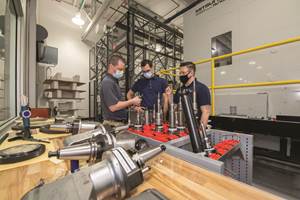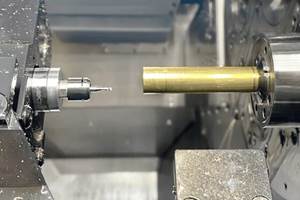Endworking Turret Cuts Cycle Time
Standard procedure for shaft work at job shop Grand Haven Steel Products was historically to soft turn, send the parts out for hardening, and then grind to the final tolerance.
Standard procedure for shaft work at job shop Grand Haven Steel Products (Grand Haven, Michigan) was historically to soft turn, send the parts out for hardening, and then grind to the final tolerance. The turning applications were not terribly demanding, as the shop typically only had to hold ±0.002 inch on any of its eight CNC lathes, and leave the precision to the grinders. There was a great opportunity to increase efficiency, however, if they could hard turn some of the parts. So in 1997, the company bought a Conquest T-51 CNC lathe (2-inch bar, 10-inch chuck capacity) from Hardinge Inc. (Elmira, New York) mainly for this task. According to manufacturing engineering manager George Stahl, on one of the first jobs the shop was able to perform a critical grooving operation on a 40 Rc shaft well within the required 0.0003-inch tolerance.
Within a year the shop saw the need to further increase productivity, and it bought a second Hardinge, a Conquest T-42 (1 5/8-inch bar, 8-inch chuck capacity). Unlike the first machine, the T-42 was fit with a "Ram Turret," which is a secondary, six-station turret used to perform on-center endworking operations. The big advantage of this machine configuration is that it allows ID and OD operations to be performed concurrently with, for example, the primary turret used for turning while the second turret is used for drilling or tapping.
The most obvious advantage of concurrent ID/OD operations is that they can substantially reduce cycle times. In one case, for example, the part was an integrally flanged shaft that required OD turning plus a bore that required drilling, tapping and chamfering. When all those operations had to be done sequentially, total cycle time for the bore side of the part was 70 seconds. When the part was moved to the T-42, however, and ID and OD operations could be performed concurrently, the cycle time was cut to just 46 seconds. That boosted average production output from the prior 26 parts per hour to the current 48 parts per hour.
But it is the combination of a machine structure that is rigid enough to handle hard turning and has more flexibility to handle ID/OD operations, as well as efficient workholding, that provides Grand Haven with the process capabilities to really boost productivity. In the case of the workpiece mentioned above, a critical diameter on a groove is monitored with statistical process control. With an upper control limit of -0.00015 inch of nominal and a lower control limit of -0.00045 inch—for a total bandwidth of 0.0003 inch—the feature stays well within control. That precision has allowed Grand Haven to eliminate a subsequent grinding operation and thus substantially lower the cost of making the part.
Workholding has a great deal to do with this capability. Like many shops, Grand Haven's first thought is to hold all but very small parts in a three-jaw chuck. But there are other options, it found, that can provide better results in some circumstances. For example, one of the first jobs run on the T-42 required holding a diameter tolerance of ±0.0003 inch, a maximum runout of 0.0005 inch from front to back and a 32 rms finish on key diameters in hardened 400 series stainless steel.
Achieving these features consistently proved difficult in the beginning. Examination revealed that the parts were not being stabilized consistently in the three-jaw chuck. On a recommendation from Hardinge, a 16c dead-length collet was sub-stituted for the jaw chuck. This enabled machining to take place much closer to the spindle face, which improved both runout and surface finish. Moreover, the collet also allowed the part to be run at higher rpm for more efficient machining. Finally, the dead-length system enabled the part length to be much more closely controlled.
Related Content
CNC Machine Shop Honored for Automation, Machine Monitoring
From cobots to machine monitoring, this Top Shop honoree shows that machining technology is about more than the machine tool.
Read MoreDigital Twins Give CNC Machining a Head Start
Model-based manufacturing and the digital thread enable Sikorsky to reduce lead times by machining helicopter components before designs are finalized.
Read MoreModern Bar Feeds Bring New Life to Automatic Swiss Lathes
Cam-actuated Swiss lathes are still the fastest way to process many parts. By adding modern bar feeders, this shop has dramatically improved their utilization with the ability to work unattended, even in a lights-out environment.
Read More3 Tips to Accelerate Production on Swiss Lathes with Micro Tools
Low RPM lathes can cause tool breakage and prevent you from achieving proper SFM, but live tooling can provide an economical solution for these problems that can accelerate production.
Read MoreRead Next
3 Mistakes That Cause CNC Programs to Fail
Despite enhancements to manufacturing technology, there are still issues today that can cause programs to fail. These failures can cause lost time, scrapped parts, damaged machines and even injured operators.
Read MoreThe Cut Scene: The Finer Details of Large-Format Machining
Small details and features can have an outsized impact on large parts, such as Barbco’s collapsible utility drill head.
Read More






.jpg;maxWidth=300;quality=90)

.jpg;maxWidth=300;quality=90)



.png;maxWidth=300;quality=90)












